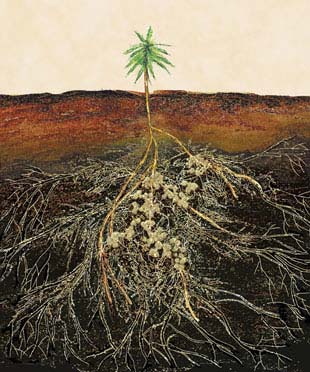By Jennifer Silver, JMMDS
Establishing a reliable phosphorus supply is essential for assuring long-term, sustainable food security….If we fail to meet this challenge, humanity faces a Malthusian trap of widespread famine on a scale that we have not yet experienced.
—James Elser and Stuart White, Foreign Policy magazine (April 20, 2010)
My blog post last week about soil prep in the vegetable garden led to a discovery that I have to pass on to our readers. Mike Ghia—a friend, local farmer, educator, and crop consultant—submitted a comment on our blog which included the following (among other useful advice): “The phosphorus in rock phosphate is largely unavailable, and is a depleting resource from human over-use.”
The other night I ran into Mike at our kids’ chorus concert and asked him about this. What I learned was astonishing. All gardeners and farmers need this information.
Phosphorus contributes to the development of all living things—plant and animal—and in its mined form, it is becoming drastically depleted. According to an article by James Elser and Stuart White in Foreign Policy magazine, to which Mike pointed me:
“Our dwindling supply of phosphorus, a primary component underlying the growth of global agricultural production, threatens to disrupt food security across the planet during the coming century. This is the gravest natural resource shortage you’ve never heard of.”
The article describes the necessity of phosphorus in agriculture, how it is lost in erosion and runoff, global mining efforts, foreign policy implications, and more. I strongly recommend reading it—and as much as you can—about this critical issue.
So, I asked Mike, what can we do? Here are some actions we can start with:
- Don’t purchase rock phosphate for the garden or conventional phosphorus fertilizers. Chemical phosphorus fertilizers are made by treating rock phosphate with acid and heat to remove other materials from the rock and to make the phosphorus more soluble and plant available.
- Do get a soil test and find out exactly what nutrients are lacking in your garden. (You’ll avoid treating nonexistent problems and inadvertently creating imbalances.) Soil tests should be done at least every 3 years or more frequently if you are attempting to make major changes in pH or nutrient levels.
- Soil tests typically only measure “available” phosphorus, not total phosphorus. Low levels of available phosphorus can often be addressed by getting soil pH into optimal levels between 6.2 and 7 (which makes existing phosphorus in your soil more bio-available). Once the pH is corrected, do another soil test, and you may find that you had adequate phosphorus levels all along, but it was not in the available form.
- Do add sources of phosphorus from organic materials such as manures, compost, and bonemeal. These materials can be tested for phosphorus levels so that you can figure out the appropriate amounts to add in conjunction with soil test results. Or you can use “book values” which can also be found on the internet.
- Reduce tillage of your soil, which damages mycorrhizae colonies that enable plants to absorb far more nutrients. No-till is optimal for encouraging mycrorrhizae growth, but not always practical for the home gardener.
- Do add mycorrhizal inoculant to your garden. Here is an online resource with an informative and interesting website.
Thanks to Mike for sharing his knowledge and expertise! I’m ordering my soil test kit today.
Mycorrhizal fungi increase the surface absorbing area of roots 100 to a 1,000 times, thereby greatly improving the ability of the plant to access soil resources. Several miles of fungal filaments can be present in less than a thimbleful of soil. Mycorrhizal fungi increase nutrient uptake not only by increasing the surface absorbing area of the roots, but also release powerful enzymes into the soil that dissolve hard-to-capture nutrients, such as organic nitrogen, phosphorus, iron and other “tightly bound” soil nutrients.
—from the Mycorrhizal Applications website

Illustration of mycorrhizae by Melissa Buntin, from an informative Fine Gardening article by Greg Quinn.







Read this with interest, but very sorry to discover the only NE distributors are in Maine and N. Vt…. none in CT, MA, RI. I hope they will correct this soon.
Phosphorus in phosphate bearing rock is insoluble, it is converted to soluble form in an acidic environment, normally microbial, and you couldn’t “deplete” it if you wanted to.
In the US, phosphate is mined and converted to soluble phosphate near large deposits in Idaho and Montana, and it is shipped as fertilizer to users.
Anyone know if it’s true that a majority of phosphorus mines are owned by the Koch brothers? I’ve heard this, and for this reason will not buy phosphate fertilizers.